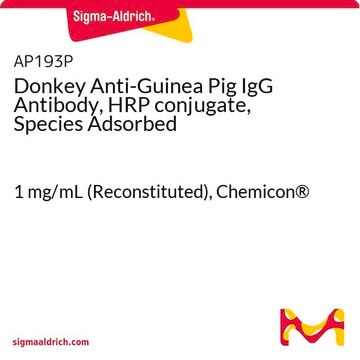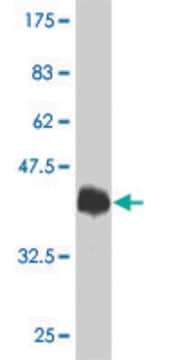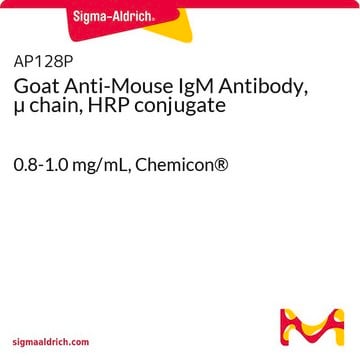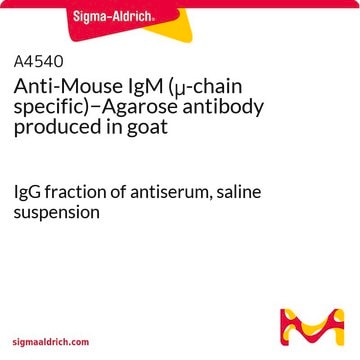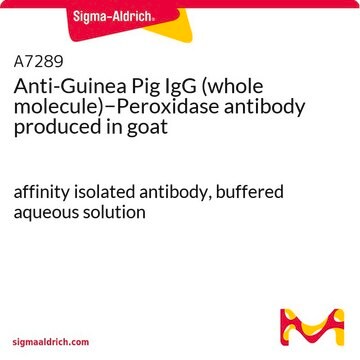AP108P
Goat Anti-Guinea Pig IgG Antibody, HRP conjugate
Chemicon®, from goat
Sign Into View Organizational & Contract Pricing
All Photos(1)
About This Item
UNSPSC Code:
12352203
eCl@ss:
32160702
NACRES:
NA.46
Recommended Products
biological source
goat
Quality Level
conjugate
peroxidase conjugate
antibody form
F(ab′)2 fragment of affinity isolated antibody
antibody product type
secondary antibodies
clone
polyclonal
species reactivity
guinea pig
manufacturer/tradename
Chemicon®
technique(s)
ELISA: suitable
western blot: suitable
shipped in
wet ice
target post-translational modification
unmodified
General description
Immunoglobulin G (IgG) is the most common type of antibody in the human serum. It exists in four isotypes IgG1, IgG2, IgG3, and IgG4. IgG is produced by the B cells. IgG structure contains four polypeptide chains with two identical heavy (H) chains and two identical λ light (L) chains. These chains are inter-linked by disulfide bonds.
Application
Goat Anti-Guinea Pig IgG Antibody, HRP conjugate has been used in immunoblot analysis and enzyme-linked immunosorbent assay (ELISA) (1:2000).
Biochem/physiol Actions
Immunoglobulin G (IgG) initiates the classical pathway of the complement system. It neutralizes virus particles and toxins. IgG plays an essential role in antibody-dependent cell-mediated cytotoxicity (ADCC). Maternal IgG is transferred to the fetus through the placenta that is crucial for protecting newborns against infectious diseases. Levels of IgG in severe acute respiratory syndrome coronavirus (SARS‐CoV)‐2 infected patients can be used as a potential tool to evaluate the severity and prognosis of coronavirus disease 2019 (COVID‐19).
Legal Information
CHEMICON is a registered trademark of Merck KGaA, Darmstadt, Germany
Disclaimer
Unless otherwise stated in our catalog or other company documentation accompanying the product(s), our products are intended for research use only and are not to be used for any other purpose, which includes but is not limited to, unauthorized commercial uses, in vitro diagnostic uses, ex vivo or in vivo therapeutic uses or any type of consumption or application to humans or animals.
Not finding the right product?
Try our Product Selector Tool.
Storage Class Code
11 - Combustible Solids
WGK
WGK 3
Certificates of Analysis (COA)
Search for Certificates of Analysis (COA) by entering the products Lot/Batch Number. Lot and Batch Numbers can be found on a product’s label following the words ‘Lot’ or ‘Batch’.
Already Own This Product?
Find documentation for the products that you have recently purchased in the Document Library.
Identification of GOLPH3 Partners in Drosophila Unveils Potential Novel Roles in Tumorigenesis and Neural Disorders
Sechi S, et al.
Cells, 10, 2336-2336 (2021)
T Hesari et al.
Archives of Razi Institute, 77(2), 739-745 (2022-10-27)
Immunization has been considered a successful global health program that saves many persons' lives each year. The vaccines reduce the risk of getting the disease by building immunity in the body. Therefore, the constant availability of essential vaccines is an
Moon Young Lee et al.
PloS one, 12(2), e0171262-e0171262 (2017-02-06)
Serum response factor (SRF) transcriptionally regulates expression of contractile genes in smooth muscle cells (SMC). Lack or decrease of SRF is directly linked to a phenotypic change of SMC, leading to hypomotility of smooth muscle in the gastrointestinal (GI) tract.
Ana Francisca Soares et al.
Journal of neuroscience research, 97(8), 1004-1017 (2019-05-03)
Diabetes impacts the central nervous system predisposing to cognitive decline. While glucose is the main source of energy fueling the adult brain, brain glycogen is necessary for adequate neuronal function, synaptic plasticity and memory. In this study, we tested the
Pauravi J Gandhi et al.
Cells, 10(10) (2021-10-24)
Chronic pain is a debilitating condition involving neuronal dysfunction, but the synaptic mechanisms underlying the persistence of pain are still poorly understood. We found that the synaptic organizer glutamate delta 1 receptor (GluD1) is expressed postsynaptically at parabrachio-central laterocapsular amygdala
Our team of scientists has experience in all areas of research including Life Science, Material Science, Chemical Synthesis, Chromatography, Analytical and many others.
Contact Technical Service
